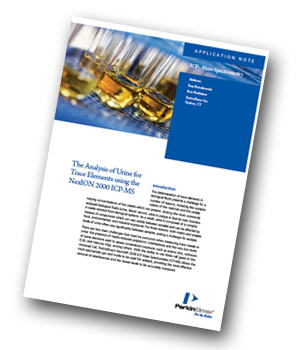PerkinElmer has produced an application note demonstrating the advantages of the NexION 2000 ICP-MS for analysis of trace elements in urine.
 Introduction
Introduction
The determination of trace elements in biological fluids presents a challenge for a number of reasons, including the complex nature of the matrices and the widely varying concentrations of the metals that are present. Among the most commonly analysed biological fluids (urine, blood, serum), urine is unique in that its main function is waste removal from biological systems. As a result, urine is composed of a complex mixture of components that can vary widely between samples and can be affected by food, environmental and industrial exposures. For these reasons, both matrix and analyte levels of urine often vary significantly between samples, posing a challenge for analysis.
Challenges and Solution
There are two main challenges that must be overcome when measuring trace metals in urine: the presence of matrix-induced polyatomic interferences and the very low levels of some elements used to assess contaminant exposure, such as arsenic (As), cadmium (Cd) and mercury (Hg), among others. With the ability to use three cell gases in the Universal Cell, PerkinElmer’s NexION® 2000 ICP Mass Spectrometer (ICP-MS) allows the most appropriate gas and mode to be used for analysis, providing the most effective removal of interferences and the lowest levels to be accurately measured.
Instrumental Conditions
All analyses were carried out on a NexION 2000 ICP-MS using the SMARTintro™ High Throughput/High Matrix sample introduction system in its standard operating conditions. To increase sample throughput, a switching valve was used with a 1 mL sample loop in flow switching mode. The carrier and rinse solutions were the same as the diluent, but without the addition of internal standards. For optimal performance, a four-mode method was used. The ability to run three different cell gases (along with Standard mode) in the same method means no compromises, resulting in enhanced accuracy and MDLs while maintaining ease-of-use.
Results and Discussion
As a result of the lack of regulatory requirements for trace elements in urine, the elements measured generally vary by lab: some analyse individual elements and others multi-element panels. Hence, the elements chosen for this work represent a typical cross-section of those analysed by a variety of labs.
Conclusion
This work has demonstrated the ability of PerkinElmer’s NexION 2000 ICP-MS to perform accurate, stable
analyses of urine samples. The unique, new solid-state RF generator produces a robust plasma allowing
accurate results to be attained using either matrix-matched or acid-based calibration curves. With the
Universal Cell and the ability to use three cell gases in a single method, the most appropriate interference reduction strategies and gases can be used for interference elimination, guaranteeing superior low-level analysis capabilities, limited only by contamination. The use of three gas channels in a single run is essential for obtaining the best interference removal without sacrificing on sensitivity and thereby resulting in improved accuracy and MDLs.
